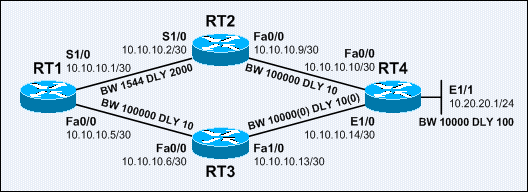The figure above shows the sample network used for the discussion of EIGRP metric calculation.
Note: RT3 treats the RT3 – RT4 link (10.10.10.12/30) as Fast Ethernet (BW 100000 DLY 10, metric 28160) while RT4 treats the link as Ethernet (BW 10000 DLY 100, metric 281600).
The destination network in question is 10.20.20.0/24, the network attached on RT4 E1/1.
Below shows the EIGRP topology table on RT4:
RT4#sh int | in Ethernet|Internet address|MTU FastEthernet0/0 is up, line protocol is up Internet address is 10.10.10.10/30 MTU 1500 bytes, BW 100000 Kbit, DLY 100 usec, Ethernet1/0 is up, line protocol is up Internet address is 10.10.10.14/30 MTU 1500 bytes, BW 10000 Kbit, DLY 1000 usec, Ethernet1/1 is up, line protocol is up Internet address is 10.20.20.1/24 MTU 1500 bytes, BW 10000 Kbit, DLY 1000 usec, --- output omitted --- RT4# RT4#sh ip eigrp topology IP-EIGRP Topology Table for AS(100)/ID(10.2.2.1) P 10.10.10.0/30, 1 successors, FD is 2172416 via 10.10.10.9 (2172416/2169856), FastEthernet0/0 P 10.10.10.4/30, 1 successors, FD is 284160 via 10.10.10.13 (284160/28160), Ethernet1/0 P 10.10.10.8/30, 1 successors, FD is 28160 via Connected, FastEthernet0/0 P 10.10.10.12/30, 1 successors, FD is 281600 via Connected, Ethernet1/0 P 10.20.20.0/24, 1 successors, FD is 281600 via Connected, Ethernet1/1 RT4#
Below shows the EIGRP topology table on RT2:
RT2#sh int s1/0 Serial1/0 is up, line protocol is up Internet address is 10.10.10.2/30 MTU 1500 bytes, BW 1544 Kbit, DLY 20000 usec, --- output omitted --- RT2#sh ip eigrp topology IP-EIGRP Topology Table for AS(100)/ID(10.1.1.9) P 10.10.10.0/30, 1 successors, FD is 2169856 via Connected, Serial1/0 P 10.10.10.4/30, 1 successors, FD is 286720 via 10.10.10.10 (286720/284160), FastEthernet0/0 via 10.10.10.1 (2172416/28160), Serial1/0 P 10.10.10.8/30, 1 successors, FD is 28160 via Connected, FastEthernet0/0 P 10.10.10.12/30, 1 successors, FD is 284160 via 10.10.10.10 (284160/281600), FastEthernet0/0 via 10.10.10.1 (2174976/30720), Serial1/0 P 10.20.20.0/24, 1 successors, FD is 284160 via 10.10.10.10 (284160/281600), FastEthernet0/0 RT2#
The EIGRP metric from RT2 to reach 10.20.20.0/24 is

Cisco IOS uses the floor() function as in C programming language when rounding floating-point numbers into decimal numbers, in which a floating-point number is rounded downward to a decimal number. Ex: 10000000 / 1544 = 6476.68 > 6476.
When RT2 calculates the EIGRP metric to 10.10.10.4/30, the bandwidth and delay between RT3 and RT4 is 10000 and 100 respectively (Ethernet), as advertised by RT4 to RT2.
Below shows the EIGRP topology table on RT1.
RT1#sh ip eigrp topology IP-EIGRP Topology Table for AS(100)/ID(10.10.10.5) --- output omitted --- P 10.20.20.0/24, 1 successors, FD is 286720 via 10.10.10.6 (286720/284160), FastEthernet0/0 via 10.10.10.2 (2198016/284160), Serial1/0 RT1#
10.10.10.6 is the successor while 10.10.10.2 is the feasible successor to 10.20.20.0/24, as the AD of the FS is 284160, which is less than the FD – 286720.






No comments:
Post a Comment